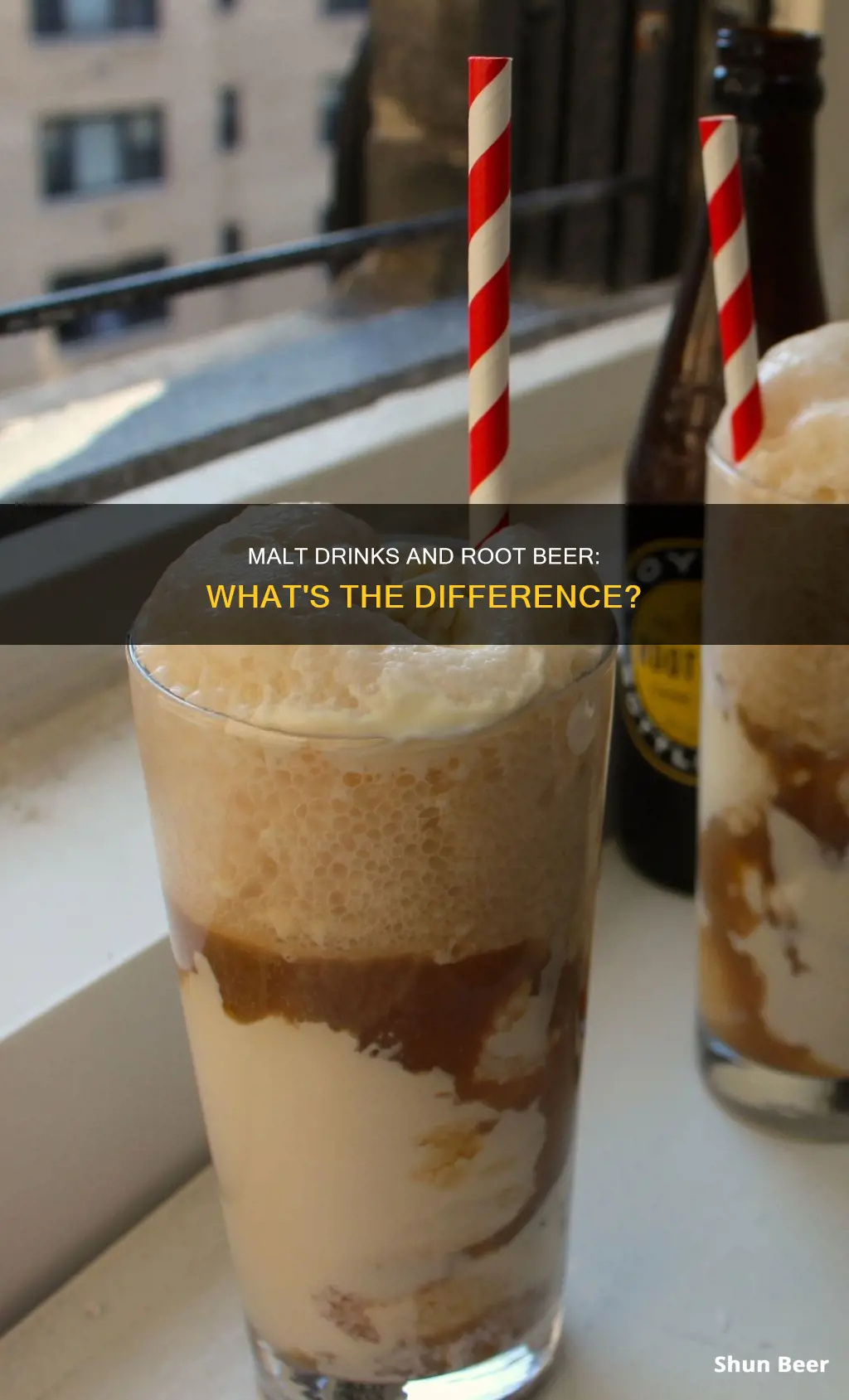
Malt drinks, also known as malt beverages, have been on the market for over a hundred years in various forms. The term malt beverage is often used interchangeably with beer, and the primary ingredient in both is malted grain, usually barley. However, the term malt beverage is also applied to flavoured drinks that are prepared from malted grains and have added natural or artificial flavours and colours to make them taste and look similar to other drinks such as wines, fruits, or colas. Root beer is one such drink, and it has a unique flavour that has riveted many for over a century.
What You'll Learn

Malt drinks and root beer are both fermented beverages
Malt drinks, also known as malt beverages, have been around for centuries and have taken on various forms. The process of malting involves soaking grains, usually barley, in water until they begin to sprout, after which they are dried and roasted. This process unlocks the full sweetness of the grain, which is then cracked or ground to release sugars. The liquid produced, called "wort", can be fermented to create a variety of drinks, including beer.
Beer, the most common malt drink, is made by boiling and steeping the malted grains in water, then fermenting the resulting wort with yeast. This produces a naturally fermented drink with an alcohol content typically above 3.2% by weight. However, "near beers" or low-alcohol beers have negligible alcohol content, usually less than 0.5% ABV.
Root beer, on the other hand, is a type of fermented beverage with a unique flavour and a long history in North America. While it may contain some similar ingredients to malt drinks, such as barley, it often includes other roots and herbs, giving it a distinct taste. Root beer is typically non-alcoholic and has a sweeter, less bitter taste compared to beer.
The term "malt beverage" is often used as an umbrella term for a wide range of drinks, including beer and flavoured alternatives. These flavoured malt beverages (FMBs) include popular drinks like Mike's Hard Lemonade and Smirnoff Ice. FMBs offer a sweeter, more approachable alternative to traditional beer, attracting a diverse range of consumers.
In conclusion, while malt drinks and root beer share some similarities in their production processes and use of fermented ingredients, they cater to different tastes and preferences. Malt drinks, especially beer, have a broader range of flavours, from bitter to sweet, while root beer maintains its distinct identity as a non-alcoholic, sweet, and nostalgic beverage.
Brewery Workers: Beer Drinking on the Job?
You may want to see also

Malt drinks are made from grains or seeds of barley plants
Malt drinks are made from grains or seeds of the barley plant. The process of converting these grains or seeds into malt for use in brewing is called malting. This involves steeping the barley grains in water for several days, encouraging them to germinate and sprout. The malting process develops enzymes that modify the grains' starches into various types of sugar, which will later be fermented into alcohol.
Once the grains have sprouted, the next step is to dry them with hot air to prevent further germination. This results in "green malt", which is then dried and toasted in an oven or kiln to the desired colour and specification. The temperature used during this stage will determine the colour of the final beer, with lower temperatures used for pale ales and lagers, and higher temperatures for darker beers like stouts and porters.
After kilning, the malted grain is ground to allow easy access to the sugars within. It is then boiled and steeped in water, releasing all the sugars into the water to create a liquid called "wort". Once the wort is cooled, filtered, and drained, it becomes a malt beverage. From here, different ingredients can be added to create a variety of drinks, including beer, malted milk, malt vinegar, and flavoured drinks.
While barley is the most common grain used for malting, other grains such as wheat, oats, rye, rice, and corn can also be used. The choice of grain and the malting process itself play a crucial role in determining the final style, colour, and flavour of the beverage.
Beer and Christianity: Drinking Responsibly as a Believer
You may want to see also

Root beer is flavoured with hops
Root beer is a sweet North American drink that has been consumed since the eighteenth century. It is traditionally made using the root bark of the sassafras tree or the vine of Smilax ornata (sarsaparilla). While root beer is typically non-alcoholic, caffeine-free, sweet, and carbonated, it can also be alcoholic.
Root beer is flavoured with a variety of ingredients, including hops. Hops are the flowers of the hop plant Humulus lupulus, a member of the Cannabaceae family of flowering plants. They are primarily used as a bittering, flavouring, and stabilising agent in beer. Hops impart bitterness, as well as floral, fruity, or citrus flavours and aromas.
In root beer, hops are used to balance the sweetness of the drink and add a bitter flavour. They also have antibacterial properties, which help prevent spoilage. While hops are a common ingredient in root beer, they are not always included, and some recipes may omit them to create a less bitter drink.
In addition to hops, other common ingredients in root beer include vanilla, caramel, wintergreen, black cherry bark, licorice root, sarsaparilla root, nutmeg, acacia, anise, molasses, cinnamon, sweet birch, honey, and various herbs and roots. The combination of these ingredients gives root beer its unique flavour and makes it a popular drink choice.
Champagne and Beer: Mixing Drinks, Safe or Not?
You may want to see also

Malt drinks have been marketed as a healthier alternative to beer
The malting process is simple: a grain, usually barley, but often also wheat or even oats, is soaked for days until it begins to sprout. It is then dehydrated and roasted or kilned. Malting grains in this way brings out the full sweetness, and this sweetness is necessary to make beer. After malting, the grain is cracked or ground, boiled, and steeped in water to make a malt beverage. From here, a variety of drinks can be made, including beer.
In the early 1900s, doctors began prescribing malt to get kids healthy. This "malt" was offered in powdered form as a cereal drink, and it led to the rise of soda fountains across the US, where people could order different flavoured "malts", essentially milkshakes. Following Prohibition, brewers began creating less expensive and more alcoholic beverages, and malt liquor was born.
Malt liquor is made with cheaper grains like corn, and it has extra sugar. This makes it sweeter and less bitter, appealing to new, younger drinkers. Most beers have less than 5% ABV, while malt liquor can have up to 9% ABV or higher. Malt liquor is often seen as a "lower-class" drink, and it is usually chosen by those who want to get drunk without spending much money.
In recent years, flavoured malt beverages (FMBs) have become popular, with brands like Mike's Hard Lemonade and Smirnoff Ice leading the way. FMBs offer a sweeter, more approachable alternative to beer and spirits, and they cater to a diverse range of consumers seeking variety and flavour options. While flavour is a significant factor in their popularity, FMB brands also need to embrace innovation and cater to evolving consumer preferences for healthier ingredients and unique flavour combinations to stay relevant.
Beer and Weight Gain: Is There a Link?
You may want to see also

Malted root beer floats are a popular dessert drink
Malted drinks have been enjoyed for hundreds of years, and malted beverages have taken on a wide range of forms. In the early 1900s, doctors would prescribe malt to children as a health boost, and this led to the rise of soda fountains across the US, where people could order flavoured malted milkshakes. Malted root beer floats are a modern evolution of this, and they are a fun, indulgent treat.
The process of malting grains is simple. A grain, usually barley, is soaked for days until it begins to sprout. It is then dried and roasted. This process brings out the natural sweetness of the grain. After malting, the grain is cracked to allow easy access to the sugars within, and then boiled and steeped in water. This liquid is then cooled, filtered, and drained, resulting in a malt beverage.
From here, there are many different drinks that can be made, and malted root beer is one of them. The addition of ice cream and chocolate syrup creates a delicious, indulgent dessert drink. Malted root beer floats are a fun, nostalgic treat, reminiscent of drive-ins and soda shops. They are a unique, tasty way to experience the sweetness of malted grains.
Beer and Candida Cleanse: Is It Safe?
You may want to see also
Frequently asked questions
A malt drink is a fermented drink that uses the grain or seed of the barley plant as its primary ingredient. The barley is allowed to sprout slightly through a process called "malting" before it is processed.
Root beer is a type of malt drink. It is a unique, fruity, and refreshing drink that has been enjoyed for over a century. It can be served on its own or as part of a root beer float, which includes ice cream and chocolate syrup.
The main differences between malt liquor and traditional beer are the flavour and alcohol content. Malt liquor tends to be fruitier, sweeter, and less bitter, with a higher alcohol content. It is often seen as a "lower-class" drink.
Some examples of malt drinks include Barbican (Middle East), Kvass (Europe), Malta (South America and Puerto Rico), Supermalt (Afro-Caribbean and UK), and Milo (Australia and Southeast Asia).







